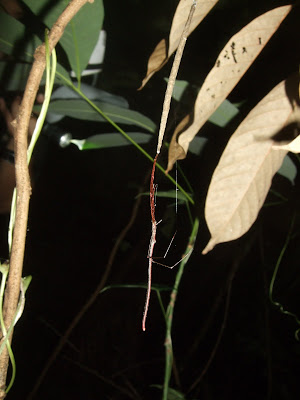An awesome (and also my first) trip to Venus Drive with James. We were greeted by frogs scattered along the pavement..
..and many of them scrambled off (literally) when we shone our torch at them unknowingly.

We sighted a couple of spiders throughout the trip, all of which I have never seen before. According to James, this is possibly a female Huntsman Spider Heteropoda venatoria, identifiable from the white bar across its face.

Lynx spider (Family: Oxyopidae).
My first sighting of a forest weevil. It is gigantic compared to the rice weevil I'm only too familiar with (don't ask why).
The identity of which I don't yet know, this spider doesn't look like most of its relatives! The 'bundle' at the top looks like it could be an egg casing. Commonly called the Whip Spider (Argyrodes, formerly Ariamnes sp.) (thanks James and Russell).

My first sighting of a forest cockroach, and boy do I love this! Far more adorable than its counterpart from America.


James checked on a bee hive found on his previous trips, but discovered with much dismay that alas, it has been destroyed and broken into pieces. I wonder what happened.



Even as we have little remaining forest patches in Singapore, there is much wildlife if only we take the time to discover them. In the next half-hour or so, we saw much amazing stuff! First up, another species of forest cockroach.

Possibly a huntsman spider (Family: Sparassidae) again (thanks James).

Common two-tailed spider (Hersilia sp.).
Cute fungus which I was unable to get a good shot of.

According to James, this could be a Garden Orb Weaver Spider (Family: Araneidae). Could it be an Australian garden orb weaver spider?



The highlight of the trip must be this cricket chewing on its meal - a caterpillar! It was my first sighting so I was really excited, and thanks to James I managed to get decent shots of the action :D



A queer looking beetle accompanied with a tiny green bug, a springtail (thanks James), on its left, a most delightful sight indeed.






















































